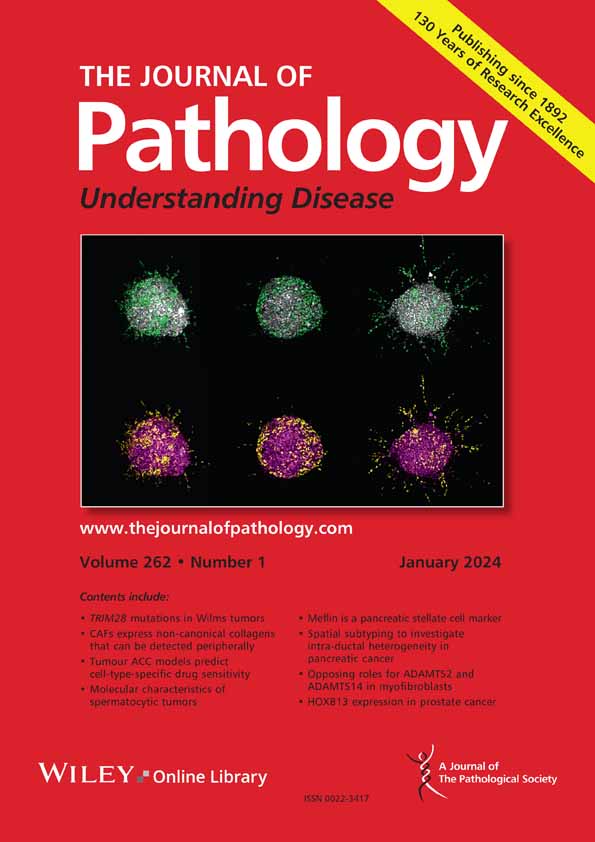下载PDF
{"title":"The importance of tumor microenvironment modulations in the progression of pancreatic intraductal papillary mucinous neoplasms†","authors":"Antonio Pea, Claudio Luchini","doi":"10.1002/path.6460","DOIUrl":null,"url":null,"abstract":"<p>Intraductal papillary mucinous neoplasms (IPMNs) of the pancreas have attracted substantial attention since they represent the most prevalent macroscopic precursor of pancreatic cancer. Most lesions show an epithelium with low-grade dysplasia and will remain indolent and unknown to the patient. Notably, a subgroup of IPMNs will progress to invasive cancer through a stepwise process characterized by the accumulation of specific genomic alterations and concomitant modifications of the tumor microenvironment (TME). The manuscript of Jamouss <i>et al</i>, recently published in <i>The Journal of Pathology</i>, expands the current knowledge on TME dynamics in IPMNs. The neoplastic progression of IPMNs is paralleled by a shift toward an immunosuppressive TME, with depletion of cytotoxic T cells, elevated expression of immune checkpoint molecules, including PD-L1 and VISTA, and increased density of macrophages. Overall, TME modifications are crucial in the progression of pancreatic IPMNs, calling for potential therapeutic strategies focused on TME modulations for cancer interception. © 2025 The Author(s). <i>The Journal of Pathology</i> published by John Wiley & Sons Ltd on behalf of The Pathological Society of Great Britain and Ireland.</p>","PeriodicalId":232,"journal":{"name":"The Journal of Pathology","volume":"267 2","pages":"126-129"},"PeriodicalIF":5.2000,"publicationDate":"2025-07-30","publicationTypes":"Journal Article","fieldsOfStudy":null,"isOpenAccess":false,"openAccessPdf":"https://www.ncbi.nlm.nih.gov/pmc/articles/PMC12438022/pdf/","citationCount":"0","resultStr":null,"platform":"Semanticscholar","paperid":null,"PeriodicalName":"The Journal of Pathology","FirstCategoryId":"3","ListUrlMain":"https://pathsocjournals.onlinelibrary.wiley.com/doi/10.1002/path.6460","RegionNum":2,"RegionCategory":"医学","ArticlePicture":[],"TitleCN":null,"AbstractTextCN":null,"PMCID":null,"EPubDate":"","PubModel":"","JCR":"Q1","JCRName":"ONCOLOGY","Score":null,"Total":0}
引用次数: 0
引用
批量引用
Abstract
Intraductal papillary mucinous neoplasms (IPMNs) of the pancreas have attracted substantial attention since they represent the most prevalent macroscopic precursor of pancreatic cancer. Most lesions show an epithelium with low-grade dysplasia and will remain indolent and unknown to the patient. Notably, a subgroup of IPMNs will progress to invasive cancer through a stepwise process characterized by the accumulation of specific genomic alterations and concomitant modifications of the tumor microenvironment (TME). The manuscript of Jamouss et al , recently published in The Journal of Pathology , expands the current knowledge on TME dynamics in IPMNs. The neoplastic progression of IPMNs is paralleled by a shift toward an immunosuppressive TME, with depletion of cytotoxic T cells, elevated expression of immune checkpoint molecules, including PD-L1 and VISTA, and increased density of macrophages. Overall, TME modifications are crucial in the progression of pancreatic IPMNs, calling for potential therapeutic strategies focused on TME modulations for cancer interception. © 2025 The Author(s). The Journal of Pathology published by John Wiley & Sons Ltd on behalf of The Pathological Society of Great Britain and Ireland.
肿瘤微环境调节在胰腺导管内乳头状黏液性肿瘤进展中的重要性
胰腺导管内乳头状黏液性肿瘤(IPMNs)是胰腺最常见的宏观前兆,因此引起了广泛的关注。大多数病变表现为低级别发育不良的上皮,患者将保持惰性和不知道。值得注意的是,IPMNs的一个亚组将通过一个以特定基因组改变的积累和肿瘤微环境(TME)的伴随改变为特征的逐步过程进展为侵袭性癌症。Jamouss等人的手稿最近发表在《病理学杂志》上,扩展了目前关于IPMNs中TME动力学的知识。IPMNs的肿瘤进展与向免疫抑制性TME的转变是平行的,伴随着细胞毒性T细胞的消耗,免疫检查点分子(包括PD-L1和VISTA)的表达升高,以及巨噬细胞密度增加。总的来说,TME修饰在胰腺IPMNs的进展中是至关重要的,需要关注TME调节癌症阻断的潜在治疗策略。©2025作者。《病理学杂志》由John Wiley & Sons Ltd代表大不列颠和爱尔兰病理学会出版。
本文章由计算机程序翻译,如有差异,请以英文原文为准。





 求助内容:
求助内容: 应助结果提醒方式:
应助结果提醒方式:


